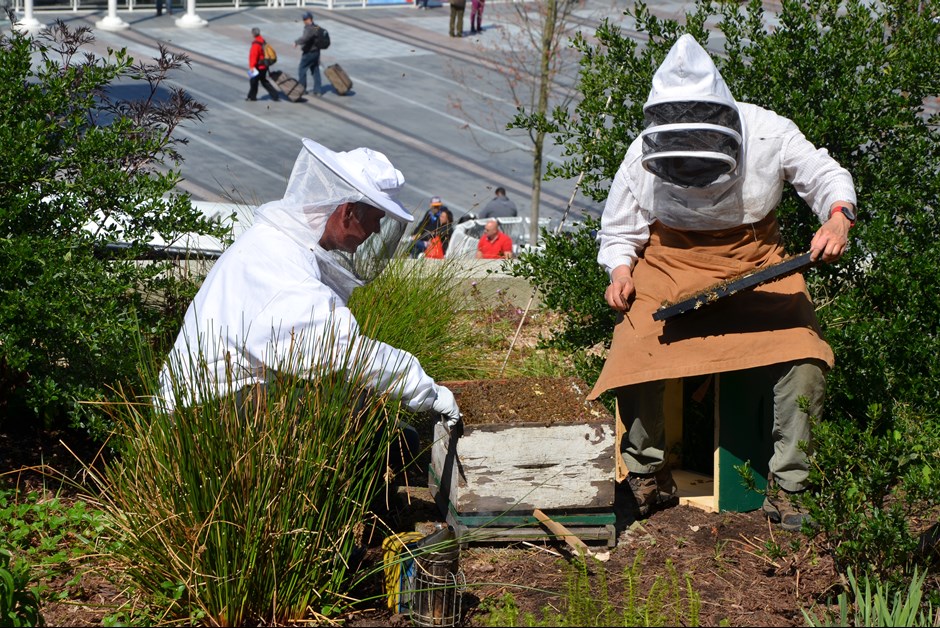The Bees are Back in Town! - The Buzz on Bees with Bee Butler Michael King (April 2015)
Learn more about Fairmont Waterfront or make a booking.
Last night under cover of darkness 4 colonies of honey bees arrived at the hotel after successfully overwintering off property at the Honeybee Centre in Cloverdale.
The bees are getting acclimatized to their new surroundings which were prepared ahead of time for their arrivals with some cleaning up of the garden area where they will call home for the next 6 months.
The bee hives were inspected this afternoon to ensure that each colony was healthy and there were no signs of any illness . All appeared to be in good shape.
Prior to entering the hive the hive is first ‘smoked’ using a dense cool temperature smoke that is traditionally created from the burning of burlap. The smoke is gently pushed out of the smoker using a hand held bellows attached to the smoker and is first placed at the entrance to the hive, then after waiting several seconds the lid is loosened and smoke is gently pushed into the upper chamber of the hive. This has the effect of making the bees think there is an emergency and they will retreat into the hive to gorge themselves on the honey. They also have difficulty communicating to each other about any danger they may face as the smoke coats their antennaes and prevents them reading each others signals about what is happening. It is all quiet harmless to the bees and creates a friendlier environment for the beekeeper as they access the hive once the lid is completely removed.
Each frame is very carefully and slowly removed from the souper and examined on both sides. The inspection looks for confirmation that the Queen is present and that there is active signs of new life in the form of eggs in the cells as well as larva which have grown to the 2nd stage or ‘pupa’ at which point they are capped by the workers. The inspection also looks for the presence of feed in the form of pollen and nectar. Another visible sign that is important to look for is evidence of any enlarged peanut shaped cells called “Queen cells’’ which occur in three circumstances. One from a lack of space in the hive for bees to live , two from a lack of a queen in the hive due to her death or three, from a queen who is failing to provide adequate egg laying abilities and is what we call ‘failing’ perhaps due to ill health . We may or may not remove these cells depending on the circumstances in the hive. This condition needs to be carefully checked and monitored. Cells are checked for signs of any illness that leaves some cells empty or with decomposed larva in them or dried up mummified larva. This is very harmful if not recognized early but if managed does not need to affect the colony to any great extent.
The frames that are full of nectar are noticeably heavier than the frames with eggs or ‘brood’ as it is called due to the density of honey which has reduced moisture levels of around 17%. Each frame is examined and then replaced in the exact same place you removed it from to ensure that each frame fits like a jigsaw piece back into the frame. The frames are checked from one end of the chamber or souper first for easy access from and back into the frame.
Once the inspections are complete and any decisions that need to be made about the hive ie adding an extra souper or removing and relocating frames to another part of the hive the lid is placed back and the bees are left alone to get comfortable again. This can take 2-3 days depending on how the bees react to the intrusion into their ‘house”.
Inspecting hives is very important but it must not be done too often so every 10 days is considered the optimum time frame as this allows the beekeeper to spot problems early if they exist.
Welcome to the 2015 season, our 9th season with the Waterfront bees ! More to come as spring unfolds into summer.
Learn more about our bees and #BeeButler at: http://bit.ly/greenhotelinitiatives
#FairmontBuzz #BeeButler #BuzzonBees



